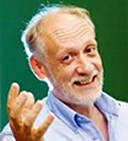Nicolas Gisin, Professor of Physics at the Université de Genève, is a true visionary and a leader among his peers. He was among the first to recognize the importance of Bell’s pioneering work, and has throughout his career made a series of remarkable contributions, both theoretical and experimental, to the foundations of quantum mechanics and to their application to practical quantum cryptography systems. His work on the latter, for instance, was highlighted in the February 2003 issue of MIT’s Technology Review as one of the “10 Emerging Technologies that will Change the World”.
We award the inaugural John Stewart Bell Prize for Research on Fundamental Issues in Quantum Mechanics and their Applications to Prof. Gisin in recognition of two of his recent contributions – it should come as no surprise that they span theory as well as experiment. One of the remarkable features of Bell’s Inequalities is that they do not rely on the assumption of any particular physical theory: they allow one to test local realism experimentally, without assuming quantum mechanics to be correct. On the other hand, the security of quantum cryptography relies on our knowledge of quantum mechanics – and usually, on our confidence that the system we are using has in fact been constructed the way we believe it has. In “From Bell’s theorem to secure quantum key distribution”, Physical Review Letters, 97, 120405 (2006), Gisin (with co-authors Acin and Masanes) follows in Bell’s footsteps and frees us from these assumptions, proving that a quantum cryptographic protocol can be shown to be information- theoretically secure based purely on observations, without any prior guarantees about the system or even the correctness of quantum mechanics.
At the same time, building on his longstanding efforts to bring quantum mechanics into the practical realm by developing sources of single and entangled photons in the telecommunications band and implementing quantum communications protocols in the 10-100 km range, Gisin has been able to extend fundamental tests of nonlocality well into the regime of spacelike separation. In “Testing the speed of ‘spooky action at a distance’“, Nature 454, 861 (2008), and “Spacelike separation in a Bell test assuming gravitationally induced collapses”, Physical Review Letters 100, 220404 (2008), Gisin (with co-authors Baas, Branciard, van Houwelingen, Salart, and Zbinden) has carried out experiments over a distance of 18 kilometers which further underscore the strength of quantum correlations. In the first, they prove any hypothetical Einsteinian “spukhafte Fernwirkungen” (spooky actions at a distance) would need to travel at least 10,000 times greater than the speed of light in any reference frame satisfying certain reasonable requirements in order to explain their observations. In the second, they have detection events culminate in the displacement of macroscopic masses, sufficiently well-separated in space that gravitationally-induced collapse theories would suggest that collapse should occur before the two detectors could communicate at the speed of light; if one believes that no measurement is complete until such a macroscopic change has taken place, then this is the first violation of Bell inequalities observed in the context of true spacelike separation between such “complete measurements”.
These latest results are major steps forward in the effort to emphasize non locality in Bell-inequality violation tests and in the goal of making truly secure long-distance quantum cryptography a reality. It is particularly fitting that, in honoring their author, we are also able to honor a researcher whose career has been so strongly associated with both fundamental and practical implications of Bell’s work.

